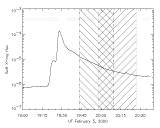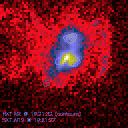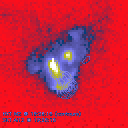
|

|
We're pleased to say that an X-class flare has already occurred in this millennium - not a remarkably major event, in spite of the gushing news release found on an alarmist BBC report. But an interesting one (aren't they all?) in several respects. In particular this was a flare that had a semi-detached precursor, itself a major event; it had powerful ejections of plasma, including the CME in the BBC movie, but not much that SXT could see. Finally the HXT sources were not really in the right places to match anyone's preconceptions. We will do our usual lightning analysis below, but we really think that these events deserve more detailed scrutiny.
Often a flare will have a early brightening, appearing to ramp up towards the main event. Theorists normally lock incorrectly onto this phenomenon, terming it a "preflare heating phase" or the equivalent. This would make sense physically: the plasma conditions in the coronal loops change gradually at first, then some threshold is crossed, and BANG! off goes the impulsive part of the flare. Unfortunately this description often is imaginary, as in this case:

|

|
It is difficult to show an upper limit for this sort of thing, but both of us have looked hard at the low-resolution SXT movies, where we have frequently seen ejecta of the most amazing kinds. In this event, we see nothing obvious, although there is a slow northward streaming in the late part of the event. The CME went off to the E, as the BBC movie shows.
Our speculation here is that it may be easier for us to see these ejecta in soft X-rays if they aren't so violent. In this case, the CME was fast and there were interplanetary type III and type II radio bursts, sure signs of a powerful disruption of the heliosphere. It's possible that in a case like this, the ejecta were simply too fast for us to catch them.
We have several things going on, seemingly independent but of course closely coincident in time and space. The soft X-ray features shown by the (860 kB) SXT movie include the M flare, the X flare, and the large arcade structure to the north of both. The arcade structure looks so detached from either of the compact flares that it reminds one of the "post-eruption loop" circumlocution that CME propagandists use instead of the more usual "post-flare loops". Maybe they're right to distinguish these! Second, a squint at the X flare shows that it looks cusp-like, something similar to the internal cusp seen in the prototype SXT cusp flare, namely that of February 21, 1992. This morphology normally stuns theorists into embarrassed silence! Finally, let us look at the HXT source locations:

|

|
The minimum contours are 10% for the M flare, and 5% for the X flare, at the limit of what HXT normally can do. The hard X-ray contours (a) don't show strongly double-footpoint structure, and (b) don't obviously anchor soft X-ray loops.
February 11, 2000
D. McKenzie (mckenzie@isass0.solar.isas.ac.jp)
H. Hudson (hudson@isass0.solar.isas.ac.jp)